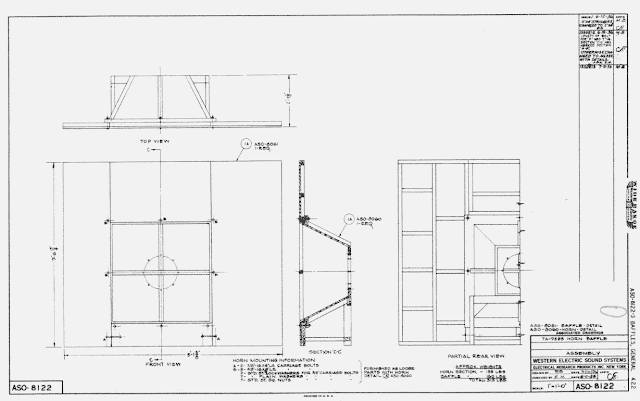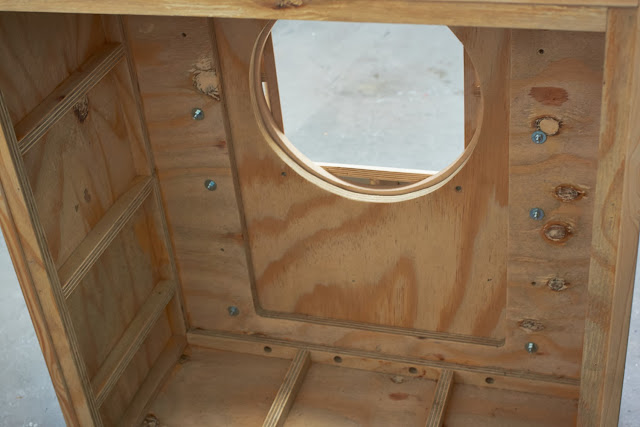Today I want to talk about the first few weeks of experience with the test cabinets. At the beginning I had difficulties to displace the slight bass boost of the Berkley cabinets from my listening habits. A fuller tone is also easier at the ear even by a skilled listener rather than a light-footed to vote. Even if one knows about the wrong tonality, this vote is more popular as a less woolly, faster and deeper -ending low frequency support.
I've never measured it, but probably the 120 liter net volume of the Tannoy cabinets ( i.e. Berkeley, Lancaster) have a strong boost in the area between 80 and 150 Hz. This boost had now given way by the open cabinets to a much more linear performance. After a few days I liked the newly acquired qualities, such as fast transient response and by far deeper resonance frequency noticeably better than my usual set up. I started to prefer the dry fastness as new and rarely to obtain quality, which is almost impossible to realize with a ducted port design and is in theory reserved to the horn principle. Acoustically I never was a fan of the sound compromise coming from the "resonator theory of Mr. Helmholtz". But in normal rooms with its typical modes it is very difficult to realize a good low frequency response with sealed cabinet designs or with alternative concepts, which in theory might do better. Everybody who knows a little bit about low frequency horns, might know the life task to realize a design sufficiently working...
 |
| Both above images show private horn installations in order to get the fastest and best LF-response possible. |
With my new and ugly cabinets I started my personal "open baffle"-concours, the first time with 15" Tannoys. The open baffle principle has got very popular again in the last two decades with lightweight vintage 8" radio console speakers, due to their cheap costs, its easy realisation and quite musical results. This wide success is not only a triumph of simplicity, but as well a clear statement about abilities of commercial standard 2-3-way hifi-speakers sold for real money during the last 30 years. On top of this there are some extremely nice speakers in the 8" full range category, which are playing in the top range independent of size. The legendary WE/Altec 755 line, the long time favorites from french Supravox and the their modern equivalents from PHY-Salabert. All of them find a perfect home in open baffle designs and are able to deliver an extraordinary musical performance with a positive reduction of complications other principles contain. Crossover design, massive resonant energy and physical size are named for a lot more complex questions to solve with bigger speakers or frequency divided designs.
Using a 12" or 15"-speaker of the 10-15kg weight range in fullrange mode with casted frames and solid magnets in open baffle designs is another challenge. Where a 12mm plywood board will do the job with small drivers, it needs here some more rigid materials and a clever design to work best. A typical 8" full range chassis will work with good results in the range of 150-8000 hz just mounted to a relative small thin board. If we want to bring a 15" chassis to support a medium frequency horn up to 200-300 hz, some old cinema designs give good advice. But If the 15" driver acts like a full range driver up to 4000 and more Hz with its inherent mechanical energy it is another question. Now the most important frequencies from 500 to 2000 will be transmitted and react with the resonant properties of the baffle design. Now it is going to be delicate and will act like an wooden instrument and other terms like solidness and size are in account. Harmonic properties are requested, just mechanical strength is the half truth to come by.
A look back into history helps a lot. Companies like Western Electric, RCA, Klangfilm and Zeiss have realized their early cinema systems with baffle designs for the low frequency support.
 |
| WE-cinema installation with three 18" field coil drivers |
 |
| WE-ASO8122 design schematic, roughly 2,40m h x 2,70m w with funnel for a 12" speaker. With this overall size the speaker should be able to work down to 50 hz. |
In the above drawing the design and construction principle of the baffle board it is clearly visible. It is made from 25mm pine plywood. These boards are highly reinforced by solid pine thick boards of 5 x 5 cm. The alternate positions of this strutting is precisely considered to prevent resonances in every part of the boards. The single boards are systemized to be screwed together to build up to final size. A overall size of 2,40x2,70m should get the system down to 50 hz, before one of the two dipolar waves will extinguish the other.
Here in my set up the cabinets act like a folded open baffle board, with a minimum distance of 125 cm from the front cone edge to the back side of the cone. It sounded almost complete, I did not miss a lot of the deeper frequencies. So I did screw 25cm stripes of plywood boards in order add depth to the frame, so the total length added to altogether 175 cm. This might have set the frequency cut down to around 60 hz. It has brought a little more increased fundament into the sound structure, but as well supported the lower mids. Since I have realized this step I am thinking about a complete inside case sliding into the outer case, which might give the perfect adjustment for the LF-resonances to couple to the room modes.
More about that ideas soon, Volker



No comments:
Post a Comment